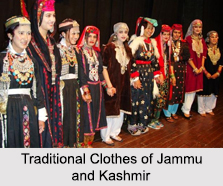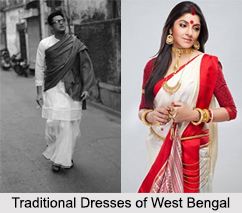Introduction
Costumes of Lakshadweep are enriched with abundance of colours. The costumes vary for men and women, whereas the costumes of the Minicoy are rather diverse than that of the rest of the population of Lakshadweep. Other than the traditional costumes, the women also embellish themselves with ornaments and jewellery. The young generation, however, are more inclined to modern western wear, than that of the traditional attires.
Costumes of Lakshadweep for Men
The tribal men, of this coastal land, other than Minicoy, adorn themselves in white or coloured Lungi. Not only men, but also women tie a silver thread round the waist. This act as a girdle for a senior person, who pulls the Lungi through the string to hold it firmly round his waist. Normally, for daily wear and tear, men do not cover themselves upwards the waist. However, in ceremonial participation, they flaunt themselves in cotton or silk drapery, invested with impressive embroidery. This cloth is passed around the shoulders. The younger generation, exhibit themselves in shirts.
Costumes of Lakshadweep for Women
The traditional costume of women comprises of "Kachi", a rectangular piece of cloth, but unstitched unlike that of men. Kachi is also known as "Chatta" in the local language. It is a long flowing skirt called 'Mundu',' worn with a blouse called 'Choli'. Kachis are, often made of silk fabric. The shades of Kachis are generally black or white with black borders. However, the silk Kachis commonly come up in red body with contrasting black borders. The jacket, on the front side, contains fine-embroidery, done with glass or gilt bits. It is topped off by a full-sleeves close-fitting jacket around the waist. The colour-smeared scarf, known as "Thattam", serves as a wonderful headdress.
Kachi: The Kachi is a graceful and essential garment in the traditional attire of women from Lakshadweep. Crafted primarily from silk, this rectangular piece of cloth is known for its rich colors and striking borders. Commonly found in shades like black, white, and red, the Kachi often features bold, contrasting edges that add to its visual appeal.
Among the various styles, the red silk Kachi with black borders stands out as a favorite for celebrations and special occasions. It represents a blend of elegance, modesty, and cultural pride. Worn by wrapping it around the body and draping it carefully, the Kachi offers both comfort and dignity, embodying the islanders’ refined sense of style.
The ensemble is typically completed with a Thattam, a colorful headscarf that enhances the look while also serving a practical purpose. Together, the Kachi and its accessories reflect the rich traditions and Islamic cultural influences of the region.
Thattam: The Thattam is more than just a piece of fabric, it's a vibrant emblem of cultural identity and grace for women in Lakshadweep. Traditionally worn as a head covering, this striking scarf is typically crafted from lightweight cotton or luxurious silk, blending functionality with aesthetic appeal. Worn draped over the head and often styled to complement the traditional Kachi attire, the Thattam serves multiple purposes. On one hand, it offers practical protection from the sun, shielding the head and hair in the island’s tropical climate. On the other, it enhances the elegance of the ensemble, bringing a burst of color and refined charm to the overall look.
Deeply rooted in the Islamic cultural influence of the region, the Thattam stands out as a signature element of Lakshadweep’s women’s attire. Its intricate designs and patterns often mirror the local art forms, showcasing the region’s rich craftsmanship and attention to detail.
Jacket: Adding depth and detail to the traditional ensemble, the embroidered jacket worn by women in Lakshadweep is a stunning example of the region’s artistry and cultural expression. This close-fitting, full-sleeved garment is usually crafted from lightweight fabric, making it ideal for the island’s warm climate while still offering elegance and modesty.
What truly sets these jackets apart is their intricate embroidery. Adorned with delicate patterns. Often floral or geometric in nature, these designs are brought to life with the use of glass beads or gilt accents, creating a subtle shimmer that enhances the garment’s beauty. Each stitch reflects the skilled handiwork of Lakshadweep’s artisans, showcasing a deep-rooted tradition of decorative needlework.
Worn over the Kachi, the embroidered jacket not only adds an
extra layer of style but also reinforces the modest aesthetic central to the
region’s clothing traditions. The careful attention to detail in every
embroidered motif speaks to the islanders’ reverence for handcrafted art and
their flair for combining practicality with refined aesthetics.
Costumes of Minicoy
There is a discrete charm about the costume of the Minicoy population. The various sections of this community namely, the Manikfans, the Thakrufans, the Thakrus and the Raveri project their own traditional dress.
Manikfan men dress themselves in the customary Lungis and shirts costume. However, the men of the remaining classes have embraced trousers, similar to the pattern of Jeans, as their daily costume. The custom is a little different for the Thakrus and Thakrufans. None is entitled to wear such trousers, except those courageous males, who have undertaken sea-expeditions. Raveri men achieve ownership of wearing these clothes, after becoming mature adults. Waistband associates the trousers. The waistband is a strip of white cloth. The upper part of the women`s body is left without clothes. The headgear emerges is a stripy red or black cloth. The number of protrusions, be it four or two, is maintained in accordance to the class-status of the various classes. The younger generation has exhibited a liking for trousers and shirts to their costumes.
The costume of the Minicoy women is an under-garment, with blue or green colours, along with a long cloak, called "Libus", stretching from shoulder to ankle. The Libus is usually seen as a brick-crimson cloth, marked with black stripes. This cloth has an opening only at the neck, with embroidery decorating that part. The practice of wearing a headdress prevails among these women. It is a strip of black cloth. At times, women use a veil-like covering, white in colour and expanding from the face down to the chin.
Accessories and Jewelleries of Lakshadweep
Ornaments are in vogue among the islander women, apart from
the Minicoy women. A waist-ornament called "Aranchan", bangles called
"Vala" or "Kodakam", ear-rings "Koodu"
and "Alikkath" and a necklace "Urukku",
are the popular jewellery items. The waist-belt could be of gold or of silver.
The Minicoy women are economical about their ornaments choices. It is the
privilege of the Manikka women, the female belonging to Manikfan class, that
they can demonstrate themselves in gold ornaments, because women of other
classes can wear silver ornaments only. In general, all women
wear a "Modram", a finger-ring.
The intricacy of design and the good choice of colours and quality of fabric of
the costumes of Lakshadweep call for recognition and praises of their taste and
preferences.





















